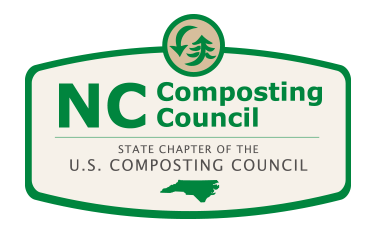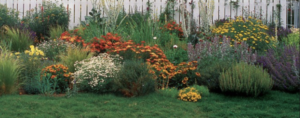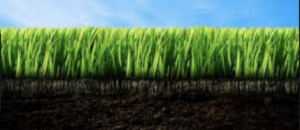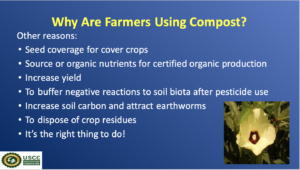Why Use Compost?
Using compost has wonderful benefits in applications from house plants to large scale farming, and in all of those applications, compost sequesters carbon. Using compost to reactivate the microbiology of the soil actually pulls carbon out of the air and fixes it in the soil. This process helps plants grow and survive challenging weather. Using compost is the a simple and very effective way that YOU can help fight climate change right now.
Here are a few basic facts about why and where to use compost.
Compost, also referred to as organic matter or humus, significantly reduces water use because it helps the soil hold moisture making it available to plant roots, and reducing erosion. Nutrients that would be washed away are retained in the soil improving plant health and crop yield.
Compost improves the structure and porosity of heavy clay soils so rain water can be absorbed through the soil instead of running off.
Compost helps to bind light or sandy soils reducing erosion and holding nutrients where plant roots can use them.
Compost helps the soil filter out and/or bind contaminants that might be contained in surface water, passively cleaning our streams and lakes.
Compost adds life to the soil, increasing soil biology and making more nutrients available to plants.
Compost Use At Home and in the Landscape
Lawns
Composted organic matter can be applied to lawns as a preparation before seed or sod are laid down. Two inches of compost should be applied to bare ground and mixed into the top 4″ – 6″ of soil before a lawn is planted. The water holding capacity of the compost aids in seed germination and encourages roots of seedlings, plugs or sod to reach down into the soil.
After the lawn is established top dressing with screened compost every year continues to build the soil adding nutrition for thicker growth and healthier grasses that are more resistant to drought, pests and disease.
Beds and Backfill
Apply compost to garden beds in a 2″ deep layer then mix it into the top 4″ – 6″ of soil with a goal of having about 5% organic matter in your soil. Once the plants are in or the seedlings are 2″ – 3″ tall, apply an additional half inch of compost around each plant as a fertilizer. Or use compost as mulch and cover the entire bed 2″ – 3″ deep.
When planting trees, bushes or any larger potted plant, dig a hole 2-3 times wider than the root ball. Blend compost into the excavated soil so the mix is about 1/3 compost. The added volume going back into the hole will create a bern around the plant sending water to the roots which will help the plant through that all important first year. Cover all of the bare soil with another 2″ – 3″ of compost.
Potted Plants
Compost, especially vermicompost, can be applied to the top of the soil in any potted plant as a fertilizer. Best of all is the compost tea that is a natural product of vermicomposting. Compost tea not only gives your plants nutrition, it fights disease, fungus, and adds to the humus in the soil.
Compost as Mulch
Using compost as mulch in your yard or garden not only looks great, but it conserves moisture, controls weeds, and improves soil biology and fertility. Apply a 2″-3″ layer of compost over all areas of bare soil.
Compost On The Farm
Here are the findings of two studies on compost use in agriculture.
1. A University of Illinois study about amending farmland soil with compost produced the following facts:
- In sandy soils, compost will increase water holding capacity by absorbing water.
- In high clay content soils, compost will improve aggregation, allowing water to move through soil faster. Following a 2nd application of amendments all amended plots increased Plant Available Water by 5 to 45% compared to the control.
- This would have potentially reduced the average amount of irrigation water needed by 10 to 90%
- At current prices, a reduction of one irrigation cycle would reduce energy costs by $270 to $620 on a 160 acre system, depending on the energy source used.
2. The Recycled Organics Units of New South Wales in Australia conducted a Life Cycle Analysis of compost and found that compost use reduced irrigation water from increased water holding capacity of 3 to 10%, thereby saving 14,000 to 100,000 gallons/acre/year.
The USCC has launched the “Strive for 5%” campaign, designed to reinforce the elevation of soil organic matter content to 5% using compost to replenish and sustain soil microbes, save water, improve nutrient uptake, reduce runoff and restore many other soil functions linked to adequate levels of organic matter in the soil.
To learn more please visit the US Composting Council’s website.
![]()














